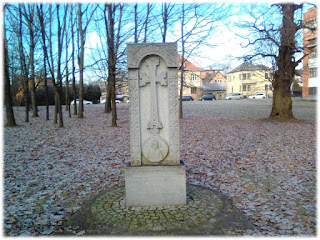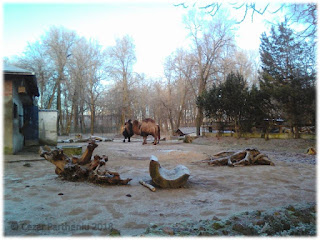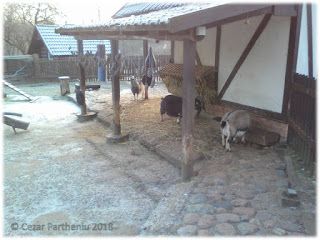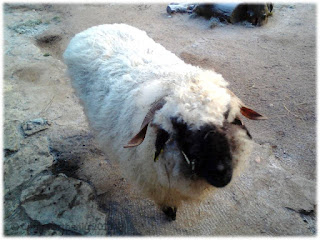Dimineață lejeră... Azi am toată ziua doar pentru plimbări... La ceaiul matinal studiez harta și văd cam pe unde aș putea să merg. Dar știți bine că socoteala de acasă nu se potrivește cu cea din târg :)! Puțin înainte de miezul zilei sunt pe drum. Pe S. Daukanto g. o bancă te invită să mai șezi un pic... Continui până în capătul străzii la K. Donelaičio g. unde sunt muzeele de artă și cel al războiului. Nu intru, doar sunt încântat de statuile din fața muzeului: mormântul eroului necunoscut, statuia libertății și statuile pacifiste ale oamenilor simpli ai muncii. Plus câteva troițe de lemn interesante!
Pe Maironito g. urc spre muzeul original despre care vă spuneam ieri.
Soft morning... Today is only for walkings... At the morning tea I study the maps for a plan. You know that the home plan is not the same with the one in the city :)! Half an hour before noon I start my day. On S. Daukanto g. street a bench invite you to sit for a while... I continue to the end of the street to K. Donelaičio g. street at at war and art museums. I don't enter, I am glad about the park and the statues: the grave of unknown soldier, the statue of liberty and the pacifist statues of the simple men of work. Plus some interesting wood crosses!
On Maironito g. street I go up to the original museum I told you about yesterday.
Este vorba de Muzeul Diavolului/Dracului (Velnių muziejus). Nu pare atractiv? Este, mai ales când știi că e unic în lume și că ai ocazia să îl vizitezi gratis: în fiecare miercuri e intrare gratis! Cumva mi s-a părut la fel de ciudat ca în multe alte muzee. În afară de mine am mai văzut doar doi vizitatori și curatorii... Intru, îmi las hainele și rucsăcelul la garderobă (acolo e un nene în vârstă cam plictisit) și pornesc la drum la etaj. Muzeul este organizat pe trei etaje plus casa memorială. Colecția de diavoli a fost inițiată de pictorul, profesorul și activistul public Antanas Zmuidzinavicius (1876-1966). Începutul colecției e mai neobișnuit. În 1906 un samoghian i-a dat pictorului o sculptură de lemn reprezentând un diavol. Ca o coincidență bizară, preotul și scriitorul Juozas Tunas-Vaizgantas i-a dat de onomastică o sculptură reprezentând un diavol învins de Sf. Mihail din sec. XVIII. Deoarece statuia era prea mare, a tăiat sfântul și i-a adus-o cu urarea să ”colecționeze diavoli toată viața”. A adunat peste 260 de statuete dăruite de prieteni și colegi. Inițial le-a ținut în casa memorială alăturată (ați ghicit, pe ea o voi vizita fără a avea voie să fac poze), le-a dăruit statului care a deschis muzeul actual în 1983. Sunt aproximativ 3000 de reprezentări ale diavolului din Lituania și din toată lumea. Sunt surprinse tradiții ca ”banul, ochiul dracului” sau muzica sau femeia ca instrumente ale diavolului, diavolul ca înger căzut, reprezentări animalice, botanice sau umane, sărbători de alungare a demonilor, fețele diavolului, diavolul și vodka, metode de a scăpa de diavol, cea mai mică reprezentare a diavolului în aur, întrunirea diavolilor, degetele diavolului, vrăjitoare, diavolul și morile de vânt, povești lituaniene despre diavoli, măști și simboluri diavolești din toată lumea (din România nu :( ), tentațiile diavolului, reprezentarea unică a lui Hitler și a lui Stalin ca diavoli (să fiți atenți să o găsiți!) și multe altele.
Nici nu îmi dau seama cum trec pașii și etajele și sunt la intrarea în casa memorială a lui Antanas Zmuidzinavicius în care atelierul este, în special, păstrat ca atare. Găsim și o descriere detaliată a casei și vă las să o citiți când ajungeți aici. La ieșire mai stau un pic lângă garderobă și văd un grup de tineri (mai mult tinere) cu o profesoară care le venise ca ghid aici. Mă bucură tare că sunt aici. Și eu și ei în locul ăsta original!
It is the Devil's Museum (Velnių muziejus). It doesn't look attractive, does it? It is, when you know that it is unique in the world and you have the ocassion to visit it for free: free entrance every wednesday! It seemed in the same strange way than in other museums. Just me, the curators and two other visitors... I enter, let my clothes and small pack at the wardrobe (I see a bored old man there) and start the visit at the first floor. The museum has three floors plus the memorial house. The collection of devils was initiated by the painter, professor and public activist Antanas Zmuidzinavicius (1876-1966). The beginning of the collection is unusual. In 1906 a samoghian gave the painter a wood sculpture representing a devil. As a bizarre coincidence, the priest and writer Juozas Tunas-Vaizgantas gave him for the name day a sculpture representing the devil defeated by St. Michael, a sculpture from XVIII century. Because the statue was too big, he cut the saint and brought to him wishing to "collect devils for the whole life". He collected about 260 stautes given by colleagues and friends. Initially he kept them in the memorial house (you guessed, I will visit it without being allowed to make pictures), gave them to the state who opened the present museum in 1983. There are about 3000 representations of devil from Lithuania and from the whole world. We can see traditions like "money, eye of evil" or music or woman as instruments of devil, devil as fallen angel, animalic, botanic or human representations, fests for chasing devil, faces of the devil, devil and vodka, ways to get rid of the devil, the smalles devil representation in gold, meeting of devils, fingers of the devil, witches, devil and the mills, lithuanian stories about devils, masks and devil symbols from the whole world (not from Romania :( ), temptations of the devil, the unique representation of Hitler and Stalin as devils (watch for this!) and many others.
I don't realize how steps and floors go and I enter the memmorial house of Antanas Zmuidzinavicius where mainly the working place is kept as original. We find a detailed description of the house and let you read when you come here. At the exit I stay a little at the wardrobe and see a group of youngs (mainly girls) with a teacher as a guide. I am glad to be here. For them and for me in this original place!
În drum spre funicular pe V. Putvinskio g. mai fac două opriri la Kauno menininku namai cu multe statui simbolice și la o casă veche de lemn pictată atractiv și viu. Chiar la intrarea la funicular mai este o statuie și un grup de muncitori care montează borduri. Vă amintește de ceva de la noi :D?
Funicularul este un semn al modernizării infrastructurii, martor al creșterii rapide a orașului (vorbim de anul 1931!). Funicularul a fost construit cu suportul specialiștilor germani și elvețieni, vagoanele fiind făcute de compania americano-lituanuană Amlit din Kaunas. Sunt surprins că nu e nimeni la casă, urc în vagonul care pornește în sus și la ieșire este un nene care îmi ia taxa: 70 de eurocenți! Cum am spus, nimica toată!
Sunt în zona înaltă din Žaliakalnis lângă biserica Învierii lui Christos. Fac câteva poze și, pe lângă gimnaziul Jono Jablonskio, merg pe Lietuvių g. spre Kauko Laptai, un canal ce începe o imensă zonă verde din fața Bibliotecii. Scopul meu este să merg prin parcul Ąžuolynas aflat nu departe în fața mea.
On the way to the funicular I make two stops on V. Putvinskio g. at Kauno menininku namai with a lot of symbolic sculptures and an old wooden house nice painted. There is another statue at the entrance of the funicular and a group of workers putting curbs. Do you remember of something from Romania :D?
The funicular is a sign of infrastructure modernisation, witness of the fast growing of the city (we are in 1931!). The funicular was built with the support of german and swiss specialists and the vans are built by the american-lithuanian company Amlit from Kaunas. There is no person at the cassa, I enter the van which goes up and at the exit a man will take me the tax: 70 eurocents! Nothing at all!
I am in the high area of Žaliakalnis near Christ Resurrection church. I make some pictures, pass by Jono Jablonskio gymnasium, walk on Lietuvių g. to Kauko Laptai, a channel that starts a huge green area in front of the library. My target is Ąžuolynas park not far away in front of me.
Intru în parc pe lângă centrul medical și stadion, las în dreapta monumentul lui S. Darius și S. Girenas și mă plimb prin parcul sălbatic pe multe dintre alei. Frunzele încă sunt înghețate, la fel și bălțile... Mă bucură să văd mame sau bunici care ies cu cărucioare cu copii pe răcoarea asta și alți copii care se joacă și nu au probleme cu frigul... Vedeți mai jos statuia unui zimbru. Mă duce cu gândul la noi și chiar voi vedea ”originalul” la grădina zoologică puțin mai încolo! Cumva ies la Radvilėnų pl., aproape de intrarea la grădina zoo...
I enter the park passing the medical center and the stadion, let the monument of S. Darius and S. Girenas to the right and walk on the alleys in the wild park. The leaves are frozen, so are the ponds... I am glad to see mothers or grandmothers with kids in wheelcarts on this cold wheater and kids playing no mind of the cold... You see the statue of an aurochs. It reminds of us and I will see the ”original” later at the zoo! I get on Radvilėnų pl., close to the zoo entrance...
Văd că prețul este de 5 euro pentru adulți și mă codesc un pic. În fond o dată în viață cred că ajung aici. La ce prețuri sunt, 5 euro nu poate însemna mult pentru hrana animalelor. Și chiar după ce văd ce animale sunt înăuntru (tot am căutat girafele și nu am putut intra la ele, acum sunt în interior fiind iarnă), mi se pare că e un preț infim. Grădina zoologică a fost deschisă în 1938 de naturalistul lituanian Tadas Ivanauskas, inițial pentru educația publicului privind protejarea naturii și promovarea conservării speciilor pe cale de dispariție. Toate animalele sunt faine și când ajung la lupul alb, parcă simt și simte ceva legătură. ”Da, de la tine din zona albă vin. Simți?” Urlă a dor cum nu mai făcuse cât am stat eu pe acolo. Fiecare animal e frumos și curios, vă invit să le vedeți pe îndelete, eu sunt un pic în grabă (aici sunt poze doar cu o mică parte din animale). Undeva prin zona vulturilor și a papagalilor găsesc o ieșire secretă care mă duce pe Slėnio g. și K. Baršausko g. la depozitele-buncăre de pe marginea dreaptă a Nemanului. Ies la Biržiškų g. și apoi la stânga ajung la podul Trijų mergelių tiltas care mă introduce în parcul-pădure Panemunes. Lumea mea! Pădure și întuneric!
I see the 5 euro price for adults and I think for a while. Once in a lifetime I get here. Knowing other prices, 5 euro can't mean too much for the food for animals. And after I see the animals inside (I was looking for the giraffes and they are closed inside now), the price looks very very small. The garden was open in 1938 by the lithuanian naturalist Tadas Ivanauskas, initially for education of visiting public regarding nature protection and promotion of conserving endangered species. All the animals are fine and when I reach the white wolf, we feel some connection. "Yes, I come from you white are. Do you feel it?" He screams for the miss of his places as he didn't before when I was in the zoo. Every animal is beautiful and curious, I invite you to see them calmly, I am in a little hurry (there are just some pics here). Somewhere in the area of eagles and parrots I find a secret exit that takes me to Slėnio g. and K. Baršausko g. streets to the bunker-deposits on the right bank of Neman. I go to Biržiškų g. street and then to right I reach Trijų mergelių tiltas/bridge that takes me to the forest-park Panemunes. My world! Forest and darkness!
Întreb un biciclist dacă pot ajunge în centru prin parc și îmi spune că se poate și că cel mai simplu este să merg pe marginea apei. Daaa, s-o creadă el! Îi mulțumesc și intru pe aleile întunecate din față. Cumva îmi găsesc potecile care mă coboară spre apă spre locul de plajă de unde văd centrul pe partea cealaltă a Nemanului. Prima casă este un restaurant, Panemunės Šašlykinė, unde cer apă și mă hotărăsc să și mănânc ceva tradițional. Aleg o Chaslama (supă de roșii picantă) și Vistienios Peteliai (cartofi prăjiți cu salată) și pâine prăjită cu usturoi (mai știți cum am mâncat în Vilnius).
Mai departe merg până la podul Panemunes alb, trec pe sub el, urc pe el și apoi traversez apa pe partea dreaptă a ei. Cobor la aleile pietonale/de biciclete care mă duc pe malul apei (incredibil câți kilometri sunt amenajați) până în dreptul Žalgiris arena și pe la podul Mickevičiaus g. tiltas urc pe strada omonimă spre casă. Găsesc un supermarket și îmi iau ceva de mâncare înainte să urc la hostel (inclusiv o pizza semipreparată, îmi era poftă).
I ask a biker if I can get to the city center and he advises me to follow the water path. Yeah, really! I thank him and follow the dark paths that take me to water to the sunbathing place where I can see the center on the other side of the Neman. The first house is the restaurant Panemunės Šašlykinė where i ask for some water and decide to eat something traditional. I choose a Chaslama (tomatoes spicy soup) and Vistienios Peteliai (french fries and salad) with fried garlic bread (how I ate in Vilnius).
Further I go to Panemunes white bridge, walk under it, then on it and pass on the right side of Neman. I follow the pedestrian/cycling alleys that take me on the bank (how many kilometers set for people) next to Žalgiris arena and on Mickevičiaus g. tiltas/bridge I follow the homonymous street to home. I find a supermarket and buy some food before going up to the hostel (including a half-prepared pizza, I was in a mood for it).
La hostel pun pizza în cuptorul cu microunde și un coleg (probabil patron sau ceva de genul) îmi spune că ar trebui să fac un duș. Da, știu, asta fac, doar să las pizza să se pregătească! E tare bine apoi curat și altfel stăm de vorbă în bucătărie. Cam acolo e locul de socializare în general... Mâine dimineață vă arăt, înainte de plecare, cum arată bucătăria :D!
At the hostel I put the pizza in the microwave oven and a colleague (probably the owner or something like) tells me that I should have a shower. I know, I do this after putting the pizza in the oven! It's so good after a shower and we can talk in the kitchen. Because the kitchen is the socializing place in general... Tomorrow morning I will show you, before leaving, how the kitchen looks like :D!














































































Niciun comentariu:
Trimiteți un comentariu